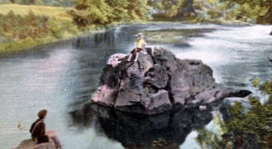The Myth of Spook Rock
Stories in Stone
The Columbia County Independent; Nov. 23, 2004
Updated by Robert and Johanna Titus
MAYBE YOU READ the Independent’s recent (2004) review of Pasquale Morrone’s book “Spook Rock.” It’s a work of fiction based on a mythology. That, of course, is not something that usually attracts the attention of a scientist. We don’t devote a lot of time to myths, but in this case we think that we can be forgiven. Morrone’s book is centered on a real rock and we always like a rock with a good story. Spook rock is located south from Rt. 23B on Spook Rock Road where it passes very close to Claverack Creek.

The legend has it that, long ago, an Indian maiden fell in love with the son of a chief of another tribe. Her father, also a chief, predictably, did not approve of this. One thing led to another; the two lovers met in the darkness at Claverack Creek. Great. A great boulder was hit by lightning and fell from the cliff above and landed upon them. They ended up crushed to death. The rock is still right where it fell and, presumably, the unfortunate lovers remain beneath it. Stay away on full moon nights!
Naturally, we could not resist going and seeing such an ill-mannered rock. It’s easy to find; it lies near the western bank of the creek, conveniently close to the road and there is very good parking. Unfortunately, we had to wade out to it. Our first scientific discovery was that spook rock has many very sharp corners to it and these are hard on bare feet.
We quickly recognized the rock; it is a piece of what we geologists call the Devonian aged (about 400 million years old) Manlius Limestone. That’s a type of rock that makes up a sizable portion of Becraft Mountain. With this, we had confirmed one important element of the myth. This rock certainly had tumbled down from the Manlius Limestone ridge above.
But soon another story began to emerge. We looked at the gray limestone and saw many thin laminations within it. We knew what these were; they are called algal laminates. Geologists have long recognized these laminations as being the fossils and ancient algae. You see, some colonies of very primitive algae grow into sheets on tidal mudflats and coat the surface with their own stickiness. As the winds and the tides rise and fall, grains of silt and clay adhere to the sticky algae and thus the laminates come to form. We looked at this and we were transported through time.
June 10, 400,002,000 BC, high noon. All around us lies a bleak flat landscape. To the west, quite some distance away, we can see an ocean. It is a beautiful aqua color. This is a peaceful sea, with virtually no waves breaking on its distant shore. It’s called the Helderberg Sea; we have been here many times before and knew what to expect.
At this distant time, Columbia County lies very close to the equator, and at this noontime hour an intense tropical sun beats down mercilessly. In short, we have arrived at a bad time. To make things worse, the Devonian age atmosphere has much less ozone in it. Today ozone shields us from ultra-violet radiation which minimizes the threat of sunburn. We feel the difference; we would not be able to stay here long before we were seriously sunburned.
All around us lies a sticky mat of dark olive colored algae. These creatures should, like us, have been baking to death in this awful sun, but they weren’t. They belonged to a breed of algae called the blue-green algae, and by the time of the Devonian they are a very old type of microbes. They have been on earth for three and a half billion years and in that time they have evolved a tolerance for intense sunlight. This noon time will pass and they will be just fine.
A wind begins to blow and soon it picks up. Now billowing clouds of dust are blowing from the highlands to the east. The dust coats the sticky algal mats and they turn white. Another lamination is being added to the countless numbers that lie below. If they are turning white, we are turning red. It is time for us to escape the Devonian and return to Claverack Creek as it is today.
Contact the authors at randjtitus@prodigy.net. Join their facebook page “The Catskill Geologist.” Read their columns in the Mountain Eagle.





